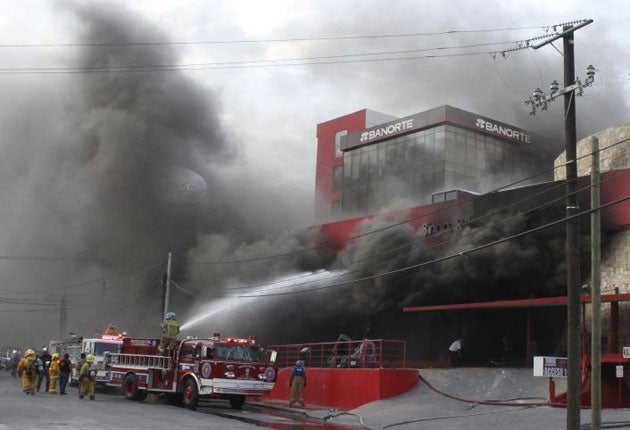More than 50 dead in casino arson as Mexico drug violence spreads

Your support helps us to tell the story
From reproductive rights to climate change to Big Tech, The Independent is on the ground when the story is developing. Whether it's investigating the financials of Elon Musk's pro-Trump PAC or producing our latest documentary, 'The A Word', which shines a light on the American women fighting for reproductive rights, we know how important it is to parse out the facts from the messaging.
At such a critical moment in US history, we need reporters on the ground. Your donation allows us to keep sending journalists to speak to both sides of the story.
The Independent is trusted by Americans across the entire political spectrum. And unlike many other quality news outlets, we choose not to lock Americans out of our reporting and analysis with paywalls. We believe quality journalism should be available to everyone, paid for by those who can afford it.
Your support makes all the difference.The northern Mexican city of Monterrey, once a model of industrial prosperity and relatively insulated from the drugs war that has gripped the country for five years, was reeling yesterday after gang members set fire to a two-storey casino in the city's centre killing at least 50 people trapped inside.
Witnesses said that the carnage at the Casino Royale began at roughly 4 o'clock on Thursday afternoon, a relatively quiet time for business at the cards tables and in its bingo salons, when gunmen stormed in shouting for people to leave before they began dousing the facility with what appeared to be gasoline.
Instead of heading for the exits, many terrified patrons and casino employees rushed further into the facility only to be trapped when the bandits ignited the liquid. The governor of the state of Nueva Leon, Rodrigo Medina, said on television that the death toll had reached at least 53 and many more had suffered injuries.
The rescue teams retrieving charred bodies found many crammed into the facility's toilets. Pandemonium erupted outside as relatives of those thought to be inside begged for information on missing loved ones with, at first, little information from the authorities.
The attack was confirmation that Monterrey, which lies 100 miles south of the border with the Texas in northeast Mexico, has now joined the scores of other parts of the country where safety from the drugs wars can no longer be guaranteed. More commonly victims of the violence are found hanging from motorway overpasses in the city. The once popular tourist city of Acapulco earlier last week saw violence surge when five headless bodies were found dumped on its streets.
In Monterrey, security has steadily degenerated as turf wars have escalated between two of the country's largest gangs competing for the lucrative drugs export trade to the United States: the Zetas and the Gulf cartels. Businesses in the city are often targeted for extortion with warnings that, unless they pay their dues to the cartels, they risk having their establishments burnt down. It was the second time the Casino Royale had been hit, the last time when gunmen sprayed it with bullets in May. No one was hurt in that attack.
Even as flames engulfed the casino and smoke was seen billowing from its windows, the authorities tried to penetrate the conflagration to save those inside, at one point commandeering heavy road construction equipment to break down its walls. For many, however, the attempts came too late.
It is one of the worst atrocities committed against an entertainment facility anywhere in Mexico since President Felipe Calderon launched his country-wide crackdown against the cartels in 2006. On Twitter, President Calderon said the assault was "an abhorrent act of terror and barbarism" that requires "all of us to persevere in the fight against these unscrupulous criminal bands".
Many of the victims of the casino attack appeared to be middle-aged and elderly women who were most often to found inside on a weekday afternoon. Among those allowed to look at some 40 bodies after the initial emergency was over was Francisco Tamayo, 28, who told reporters he was looking for Sonia de la Pena, his 47-year-old mother. "She's probably here," he said, dialling her number on his cell phone.
While the authorities have heralded the capture mostly this year of a succession of top cartel bosses, Mexico has paid a high price for Mr Calderon's anti-drugs campaign, with the death toll somewhere over 41,000 over five years.
Join our commenting forum
Join thought-provoking conversations, follow other Independent readers and see their replies
Comments